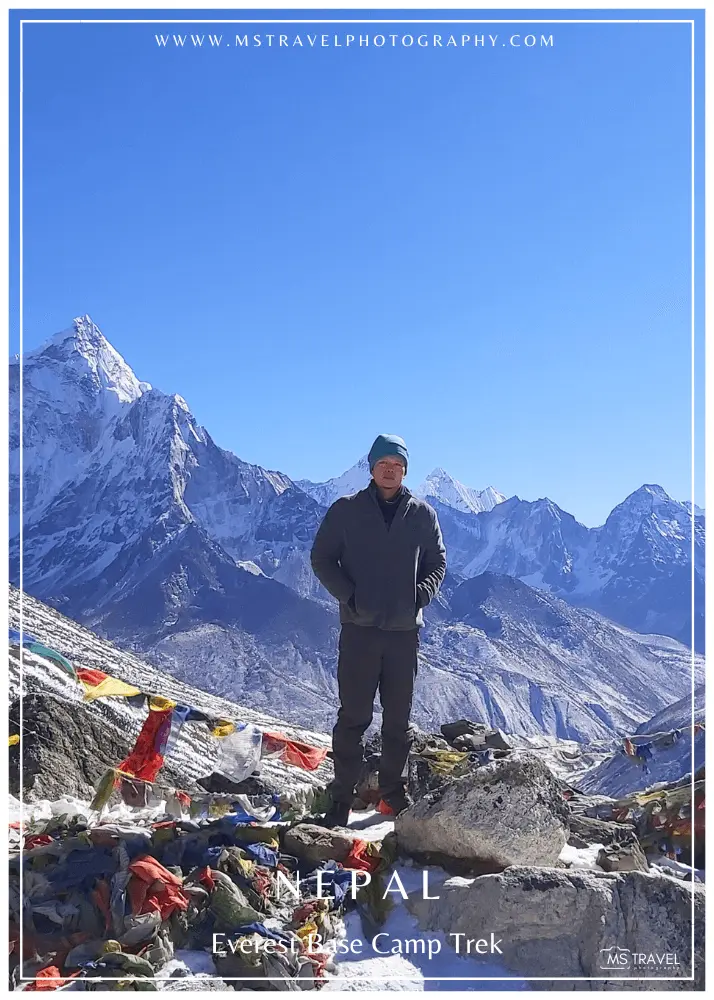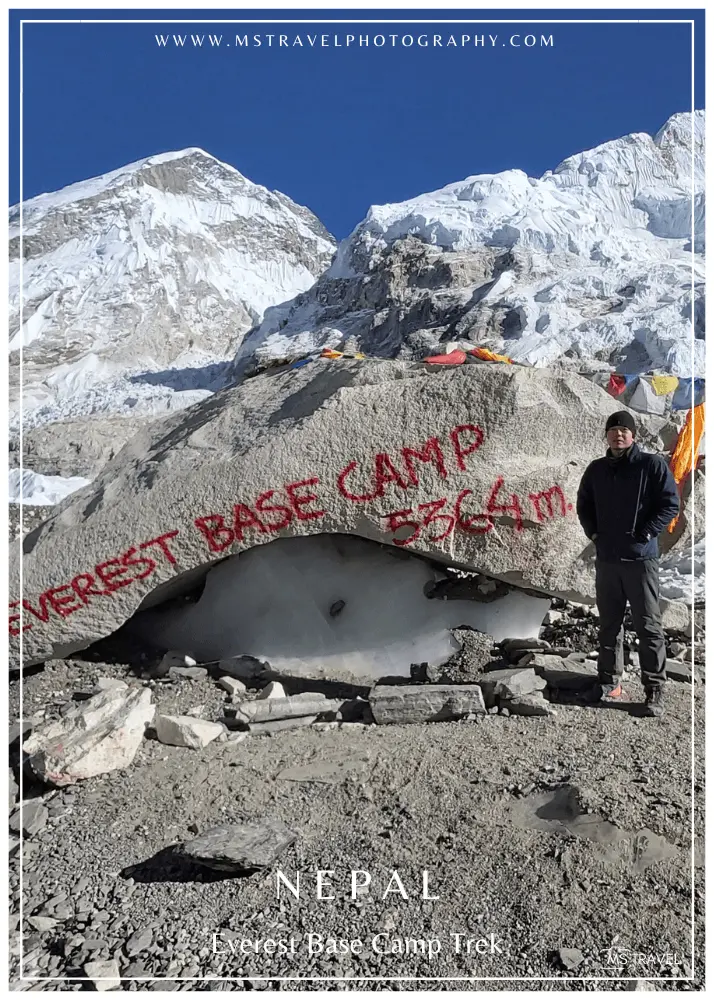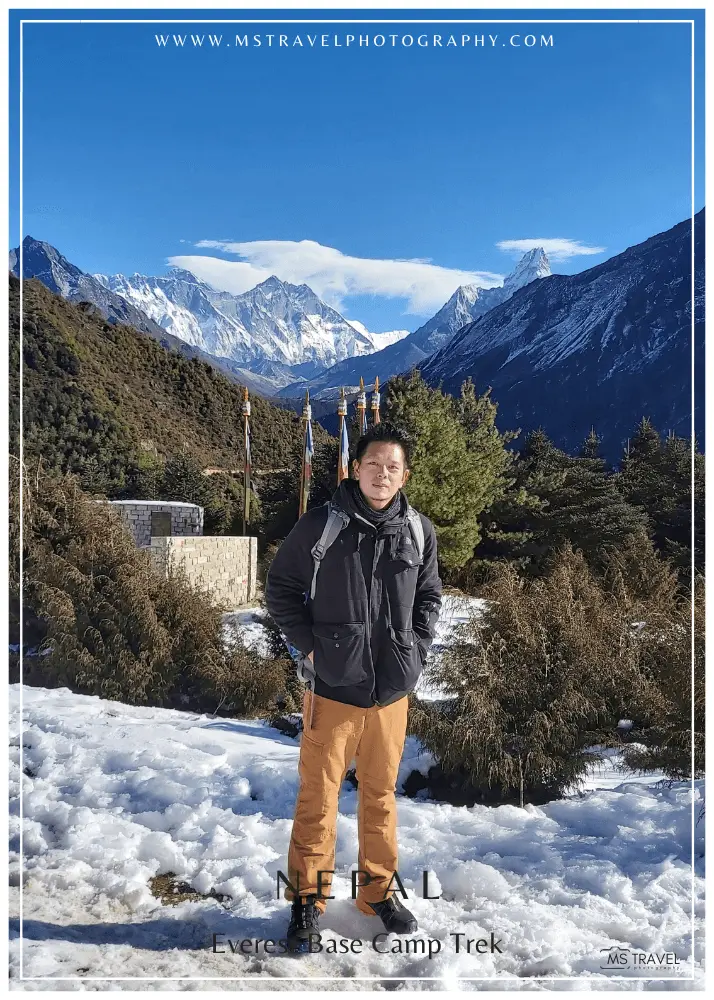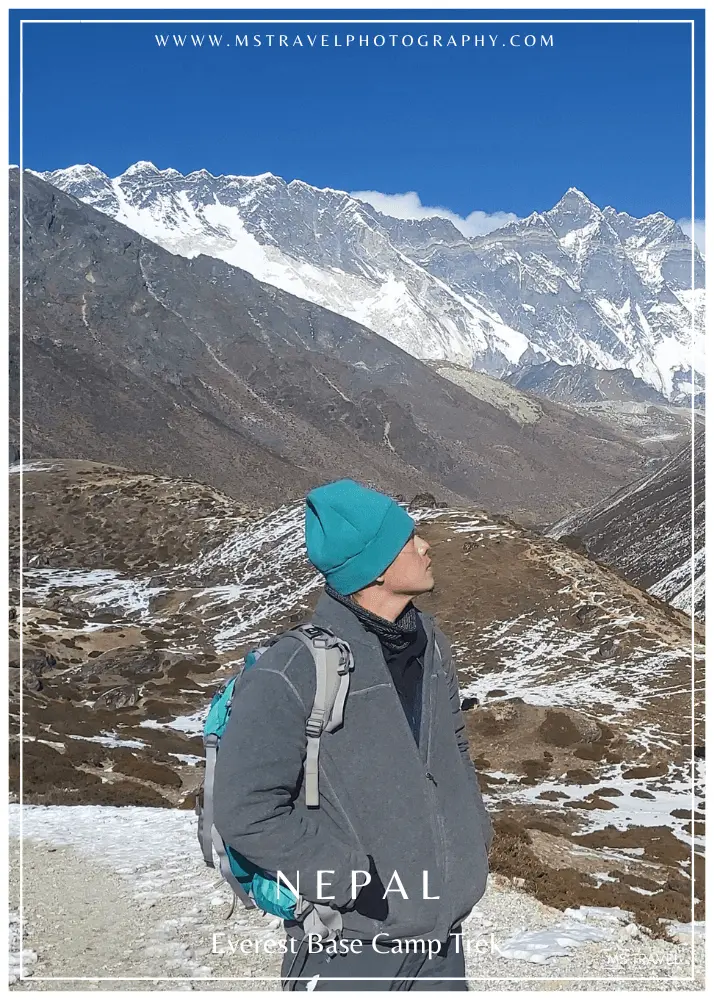Elevation and Emotions: My Personal Journey to Everest Base Camp Trek
Overview
Climbers have been enthralled with the Himalayan Mountains’ magnificence for millennia. Mount Everest is the gem in the crown, the pinnacle of nature’s majesty and the ultimate test of human endurance among its towering peaks. The route to the summit’s base camp is an experience in and of itself, offering a deep dive into Nepal’s beautiful landscapes, colorful cultures, and, perhaps most significantly, one’s own fortitude and resolve. However, the summit itself attracts climbers with its seductive call.
I decided to take on this challenge in December 2019 since it had been a goal of mine for years, a fantasy filled with wanderlust. I would travel 120 kilometers in 11 days, experiencing a variety of hardships from bitter cold temperatures to the thin alpine air that strained my ability to breathe. This was more than simply a physical journey—it was a voyage of self-discovery, a bonding experience with other trekkers, and an example of the strength of human will.
However, this is not my tale alone. It’s a quilt of stories and experiences laced with priceless pearls of wisdom for those who want to take this trip on their own. Take this as a record of my own journey as well as your go-to manual for climbing Everest Base Camp—a beacon calling to all would-be mountaineers from the depths of the Himalayas.




Quick Trek Facts
Starting a climb to Everest Base Camp is no easy task, and the adventure, with all of its trials and thrills, is as about the minutiae as it is about the majesty of the Himalayan scenery. Here are a few brief but crucial details that give an overview of the journey and set the stage for the detailed story that follows:
Elevation Triumph
At 5,364 meters (17,164 feet) above sea level, Everest Base Camp is a breathtaking sight. This elevation is more than simply a number; it’s evidence of the lengths to which the human spirit can go when confronted with the difficulties of nature.
The Length of the Trek
At 120 kilometers long, the journey is about more than the destination. Each kilometer encountered presents a different mosaic of sights, sounds, and sensations, so the journey itself becomes an essential component of the adventure.
Time’s Passage
Although the trip only lasts 11 days from beginning to end, it is jam-packed with experiences that will last a lifetime, including physical challenges and events that change people’s lives.
Turned the Pages of the Calendar
My journey took place from December 21, 2019, to January 3, 2020. These dates signify not just the arrival of winter and the end of the year, but also a significant turning point in my life as a long-held desire came true at the start of a new decade.
These facts are the cornerstones around which the narrative of the Everest Base Camp expedition is constructed, regardless of your level of experience or desire to travel in the same way. They offer a background, placing the difficulties encountered and the victories attained in perspective.
Preparation for the Trek
As they say, “The well-prepared prosper.” When it comes to trekking to Everest Base Camp, this is very true. Going into the heart of the Himalayas means not only having a strong sense of adventure but also careful planning, a combination of physical and mental preparation, and knowledge of the particular difficulties that the area presents. Here’s a detailed look at how I prepared for this enormous journey:
Research and Reconnaissance
Many hours were spent searching through books, documentaries, and blogs long before the first foot on the route. Getting knowledge from past hikers’ experiences was extremely helpful in identifying possible obstacles, schedules, and even the hidden gems.
Physical Preparation
The journey to Everest Base Camp is not your typical climb, and the Himalayas are not just another mountain range. It requires perseverance. A few months before, I started an intense training program that included long-distance running, hill climbing, and even workouts tailored to altitude to increase lung capacity and stamina.
Selecting the Correct Gear
The gear you carry with you can make or break the success of the walk. As the temperature dropped to -27°C, I made sure to pack warm clothes, sleeping bags suitable for the height, and sturdy hiking boots. Each piece of equipment underwent testing and trials to guarantee its comfort and performance.
Mental Toughness
Reaching Everest Base Camp requires mental toughness in addition to physical strength. Reminding oneself of the enormity of the Himalayan scenery, the possibility of altitude sickness, and even talking to previous trekkers were helpful mental preparation techniques.
Comprehending Acclimatization
The air gets thinner as you ascend higher. I took the time to learn about the acclimatization process, including how to identify the signs of altitude sickness and when to push through and relax. This information guaranteed not only one’s own safety but also the enjoyment of the walk.
Local Nuances & Cultural Etiquette
The Everest area is home to thriving Sherpa villages in addition to snow-capped peaks. Understanding local customs, traditions, and etiquette was another important part of being ready for the voyage. This enhanced the encounter and encouraged a closer bond with the land and its inhabitants.
To put it simply, getting ready for the hike was an adventure in and of itself, requiring perseverance, commitment, and an acute awareness of the subtleties of what lay ahead. However, the success and enjoyment of the walk depended heavily on the preparation that went before, as with any major undertaking.
Day-by-Day Account
The journey to Everest Base Camp was a journey filled with experiences and emotions, with each day bringing with it new obstacles and rewards. Even if it’s not feasible to record every moment that passes by, this is a distilled account of the voyage, day after difficult day:
Day 1: Lukla to Phakding
The journey began in Lukla, the entry point to the Everest area. Arriving at the renowned difficult Tenzing-Hillary Airport was an exhilarating start. We arrived at Phakding after a modest hike, where we got our first views of the magnificent Himalayas.
Day 2: Phakding to Namche Bazaar
The intensity changed with the scenery. After across the Dudh Koshi River and its suspension bridges, we saw the beginning of the actual climb to Namche Bazaar, the capital of the Sherpa people. This vibrant city is surrounded by breathtaking mountains.
Day 3: Acclimatization at Namche
An important day for getting used to the altitude. While our bodies acclimated to the thinner air, we took short treks around Namche, which included a visit to the Sherpa Museum, which offered insights into the history and culture of the area.
Day 4: Namche Bazaar to Tengboche
The trek revealed the splendor of the Himalayas, offering first looks of Mount Everest. We saw the famous Tengboche Monastery, a spiritual lighthouse amidst the mountains, before coming to an end at Tengboche.
Day 5-7: En Route to the Base Camp
Every day the landscape became more difficult, but also more breathtaking. We made our way across frozen streams, moraines, and rugged slopes as we passed through towns like Dingboche and Lobuche. One of the highlights of the trip was seeing the Khumbu Glacier, which indicated that we were getting close to base camp.
Day 8: The Everest Base Camp
the conclusion of several days of hiking. Exhaustion, excitement, and a deep respect for the magnificence of nature were all overpowering feelings as one stood at base camp with the Everest peak towering overhead.
Day 9-11 The Descent and Reflection
The return trip offered an opportunity for reflection and a fresh appreciation of the surroundings. With every step came the realization of a dream come true and the approaching end of a life-changing journey, both bittersweet.
This day-by-day narrative captures the physical, mental, and spiritual rollercoaster that the climb to Everest Base Camp encompasses, however each trekker’s experience will be unique. It is proof of the tenacity of people, the attraction of the natural world, and the unwavering spirit of adventure.
Personal Difficulties and Achievements
Every trip has its share of ups and downs, but none as intense as the journey to Everest Base Camp. These are the furnaces where memories are created and human development takes place. This is an account of my own struggles and the successes that made the trip genuinely remarkable.
Dealing with the Severe Cold
The bitter cold was a constant enemy as temperatures dropped to a bone-biting -27°C. Each stride in the freezing air and each evening spent in the unheated tea rooms served as evidence of the body’s tenacity and the willpower of the mind.
Physical Ailments – A Constant Test
- Sprained Ankle: The rough paths were dangerous, and a slip sent an ankle spraining hurting. But I persisted, one cautious step at a time, with the help of other hikers and my own will.
- Altitude Sickness: The body was tricked by the thinner air. Breathlessness and pounding headaches were my usual companions, but knowing the need of acclimatization and listening to my body’s cues prevented serious sickness.
- Blisters: A few small injuries occurred every day. However, every blister and bruise served as a visible reminder of the day’s adventure and a badge of pride.
- Flu and Colds: The body’s defenses occasionally weaken under the intense cold and physical strain, resulting in episodes of flu and enduring colds. But these obstacles were surmounted with the right attention and recuperation.
Mental Battles
The mind required continual support more than the body did. Moments of uncertainty, exhaustion, and homesickness threatened to obscure the joy of the adventure. But with the support of other hikers, the breathtaking scenery, and sheer willpower, the mental fog continued to lift.
Joyful Times
- Arriving at the Base Camp: There are no words to describe the immense feeling you get when you walk into the base camp. It represented the achievement of many obstacles surmounted, as well as ambitions and efforts.
- Developing a Bond with Other Trekkers: I met people from all over the world on my trek. Friendships were established that would last a lifetime because of the camaraderie, shared hardships, and group joys.
- Accepting the Local Culture: Interacting with the Sherpa people, taking part in their customs, and learning about their way of life in the mountains were all eye-opening experiences that really enhanced the journey.
Looking back, it’s clear that the difficulties encountered increased the significance of the victories. Every challenge surmounted added complexity to the tapestry of memories built during the walk, and every low made the highs even more thrilling.
The Trek Fellowship: Honoring a Diverse Group
Among high peaks and deep valleys in the vastness of the Himalayas, a special friendship was formed. Twelve people with different backgrounds who are united by a common objective and a sense of camaraderie. Despite having various origins, ethnicities, and life stories, we came together as a group on the routes going to Everest Base Camp, with each person adding to the resiliency and vitality of the whole.
The Global Tapestry
From the US and Poland: Isabella, Bryan and Olga frequently led the group in songs and stories thanks to his endless energy. Cydney and Warren were a source of warmth and companionship, particularly in the chilly months of December.
From Canada: Everyone enjoyed Katie’s birthday celebration, and her contagious spirit of adventure.
From India: The depth and complexity of our shared experiences were enhanced by Kritesh’s contagious laughter, Nirbhay’s calm persistence, and Gajanan’s knowledge from past treks.
Special Mentions
Our Main Guide: A description of our journey would be incomplete if we did not acknowledge Pemba, our primary guide. His proficiency, familiarity with the area, and boundless tolerance not only guaranteed our security but greatly enhanced our pleasure. Our excursion gained depth from his stories about the area, its mythology, and his own experiences.
The Ties that Formed
A helping attitude emerged when common struggles, such as overcoming altitude sickness or negotiating difficult terrain, were encountered. We encouraged one another on challenging climbs and acknowledged each small accomplishment.
The daily get-togethers at the tea rooms transformed into conversations with anecdotes, jokes, and occasionally, reflective quiet moments. Our comprehension of one another’s worlds expanded as a result of the cultural interactions.
When one trekker felt vulnerable—due to physical tiredness or loneliness, for example—other trekkers stepped in to provide support and encouragement.
Lasting Recollections
Together, we became more than just fellow travelers under the shadow of the Himalayas—they were an adopted family. The excursions were full of shared meals, tales, and moments of communal astonishment at the beauty of nature. Most importantly, though, was a mutual respect that cut over our differences in origins.
It was clear as we made our way down from Everest Base Camp that although the expedition had come to an end, the friendship would never die. A monument to the enchantment that occurs when disparate spirits connect on a common road, the shared experience, the memories made, and the relationships forged destined to last.
Celebrate Worthy Events: More Than Just a Journey
There were times, among the rough paths, exhilarating ascents, and breathtaking views, when the warmth of celebration shone brightly. Because these experiences were ingrained in our voyage, it became more than just a search for a destination—rather, it became a symbol of happiness, companionship, and the fundamental nature of life—even in the most trying circumstances.
1. The Mountain Birthday of Katie
A specially cooked cake to commemorate Katie’s birthday was waiting for us all when the sun rose beyond the snow-peaked horizon. With the majestic Himalayas in the background, we cheered, sung, and savored a moment of surprise and happiness. This day demonstrated the closeness of our hiking family as well as being a personal achievement for Katie.
2. An Unforgettable Christmas
Christmas in 2019 wasn’t decorated with snow-covered trees or sparkling lights. Rather, the pure snow of the Himalayas and the generosity of spirit distinguished it. This mood was elevated by Cydney and Warren, who gave each of us priceless mementos of our trip that quickly became treasured keepsakes. We wrote a Christmas tale that was original, touching, and unforgettable together.
3. Celebrating the Start of 2020
At the conclusion of the year, we were among the natural giants. There was a tangible sense of excitement as midnight approached. There was a lot of laughter, clinking of glasses, and even some spontaneous dancing in the thin alpine air. In keeping with the local vibe, a few members of the company toasted to fresh starts in the heart of the Himalayas while indulging in customary beverages.
These festive occasions were not only times on a calendar. They represented the capacity of the human spirit to find happiness in the face of adversity. They served as a reminder that, even in the face of the immensity of nature, interpersonal relationships and group gatherings may have a special ability to firmly establish our feeling of identity and belonging.
The Ultimate Guide to Conquering Everest Base Camp Trek
From Lukla to Everest Base Camp: A Trekker’s Essential Guide
10 Essential Tips for Aspiring Trekkers
Trekking to the base of Everest is an incredible opportunity as well as a formidable task. The mountains have an alluring draw, but getting there requires planning, reverence for the environment, and a clear awareness of one’s own limits. Based on my own experiences, the following are essential guidelines to guarantee a fruitful and fulfilling voyage for anyone motivated to take on this adventure:
1. Know What to Expect
It’s not only about getting to base camp; the journey is about all the experiences you have along the way. Get acquainted with the daily schedule, the landscapes, and the different elevations.
2. Physical Preparation is Crucial
Train for months ahead of time. Include weight training, cardiovascular exercises, and, if you can, altitude training. Recall that having a healthy body lowers the chance of illnesses and injuries.
3. Invest in Good Equipment
Don’t skimp on necessary equipment. Make sure you have a strong set of trekking boots, warm, breathable gear, and a high-quality sleeping bag that can withstand extremely low temperatures.
4. Acclimatization – Slow and Steady
As you ascend, the chance of altitude sickness grows. Make sure to factor in extra days for acclimatization when planning your journey, particularly if it will take you to Namche Bazaar.
5. Nutrition & Hydration
To keep hydrated, sip lots of water. Stay away from alcohol since it might make altitude sickness worse. Eat a well-balanced diet that provides enough carbohydrates for energy.
6. Respect Local Traditions
Culture of the Khumbu area is rich. Discover the traditions and customs of the area. Simple actions such as circumnavigating religious buildings in a clockwise manner can demonstrate respect for the culture of the place.
7. Hire a Reputable Guide and Porter
A competent guide can provide navigational assistance as well as information on the local way of life, natural history, and wildlife. While this is going on, porters can lighten your physical load so you can enjoy the walk to the fullest.
8. Always Be Ready for Emergencies
A first aid kit should always be on hand. Learn how to provide basic first aid, and always carry necessary medications, such as those for altitude sickness.
9. Stay Connected
Even though the area is rural, communication options exist. For emergencies, think about purchasing a local SIM card or renting a satellite phone.
10. Travel Light But Cautiously
Just bring what you need, but make sure you have supplies in case the weather unexpectedly changes. Make sure everything is waterproof and arrange your equipment using packing cubes.
Finally, keep in mind that the trip is just as important as the destination when trekking. Accept and enjoy every second, every obstacle, and every beautiful vista. Aspiring trekkers may make sure that their trip to Everest Base Camp turns into more than simply a hike by arming themselves with these pointers and a sense of adventure.
Pre-Trek Logistics
An Everest Base Camp trek’s success depends as much on careful pre-trek planning as it does on the actual route. Taking care of the logistics guarantees a more seamless, secure, and joyful experience. The following is a thorough analysis of the logistical factors that each hiker needs to think about:
1. Travel Documents
Verify that you possess the required visa for Nepal. It’s advisable to verify ahead of time, although most nations may obtain a visa upon arrival in Kathmandu.
Trekking Permits: The Sagarmatha National Park Entry Permit and the TIMS (Trekkers’ Information Management Systems) card are needed. Both are available in Kathmandu.
2. Flight to Lukla
Usually, the journey begins at Lukla. Plan your travel to Tenzing-Hillary Airport in Lukla from Kathmandu. Weather-related delays or cancellations of these flights are common, so allow extra days for them.
3. Insurance
Invest in complete travel insurance that includes coverage for hiking at high altitudes and, most importantly, helicopter evacuation in the event of an emergency.
4. Guides and Porters
Your hiking experience might be enhanced by hiring a reliable guide. Along with showing the route, they also share their knowledge of the local customs and environment. Conversely, porters may assist you in carrying your bulky equipment, making your walk easier.
5. Accommodation in Kathmandu
You will probably be staying in Kathmandu both before and after the hike. In particular, reserve your lodging well in advance of the busiest hiking seasons.
6. Immunizations and Health Safety Measures
Speak with your physician about recommended immunizations, such as those for rabies, typhoid, and hepatitis A. Talk about altitude sickness as well as ways to avoid it.
7. Packing
Think about the hiking season you are in. Thermal apparel, waterproof clothes, hiking boots, a sleeping bag, and personal first aid are typically considered necessities. Recall that while being organized is important, it’s just as important to avoid overpacking.
8. Local Currency
There are lots of ATMs in Kathmandu, but not in the Everest area. Take out enough Nepalese Rupees in cash before starting the hike.
9. Connectivity
If you want cell phone access in Kathmandu, think about purchasing a local SIM card. Ncell has fair coverage in the vicinity of Khumbu.
10. Itinerary and Buffer Days
When planning your trek, account for days needed for acclimatization. It is also a good idea to allow a few extra days in case there are unanticipated delays, particularly from bad weather.
11. Equipment Rentals
In case you’ve forgotten anything or don’t want to buy hiking equipment, there are plenty of stores in Kathmandu where you may purchase or rent it.
It might really help to make sure that these logistical components are in place before you go. In addition to removing possible obstacles, it also frees hikers from needless distractions so they may concentrate entirely on the journey’s challenges and beauty.
Culture and Environment
Traveling to Everest Base Camp is a great way to see both the unique Sherpa culture and the many ecosystems of the Khumbu region, in addition to being a tribute to the majesty of nature. Here’s a look at the natural and cultural elements that enhance this hike beyond its strenuous physical nature:
The Community of Sherpas
In the center of the Himalayas: The Everest area is inextricably linked to the Sherpa community. In addition to being well-known for their climbing prowess, they are also the guardians of the distinctive local culture.
Religion and Spirituality
There are several monasteries, stupas, and prayer wheels around the area. The Sherpas place a high value on Buddhism, and hikers will frequently come across colorful prayer flags waving in the breeze, spreading good thoughts to everyone.
Festivals & Celebrations
Trekkers may be able to see colorful dances, music, and rituals during regional celebrations like Mani Rimdu and Dumji, if their timing is correct.
The Sagarmatha National Park’s Biodiversity
The Sagarmatha National Park, a UNESCO World Heritage site, is traversed via the hike routes. Numerous endangered species, including the Himalayan tahr, red panda, and snow leopard, may be found in this protected region.
The park is home to a wide variety of habitats, including alpine meadows, glacial moraines, and lush pine and rhododendron woods. The vegetation and wildlife change with height, providing a varied natural experience.
Local Cuisine
In spite of its distant location, the Khumbu area provides a variety of regional specialties. Foods like momos (dumplings), Sherpa stew, and Dal Bhat (lentil soup with rice) are savory and healthy, giving trekkers energy.
Due to its distinct flavor and comforting qualities, butter tea—a traditional beverage brewed with tea leaves, yak butter, and salt—is a must-try.
Crafts and Memorabilia
Local markets are common in the communities in the area, where craftspeople sell their handmade wares. These mementos encapsulate the spirit of the Himalayas, ranging from handcrafted jewelry and wooden items to elaborately woven pashmina blankets.
Eco-Friendly Travel
Respect for the environment is ingrained in the local mindset. It is recommended that tourists limit their carbon impact, support local companies, and adopt sustainable behaviors.
Architectural Marvels
In addition to its stunning natural surroundings, the area is home to architectural marvels like the Tengboche Monastery, which serves as both a significant spiritual center for the Sherpa people and a superb example of Tibetan Buddhist architecture.
The journey to Everest Base Camp is essentially about exploring a diverse range of cultures, customs, and ecosystems in addition to climbing high heights. By interacting with these aspects, hiking becomes a voyage of both exterior vistas and inside contemplation.
Health and Safety on the Trail: 11 Important Safety Reminders
Trekking to Everest Base Camp is a once-in-a-lifetime experience. However, the possible hazards to one’s health and safety also change when one moves from heavily forested areas to arid alpine zones. Tackle these head-on for a voyage that is both unforgettable and incident-free. Here is a list of recommended procedures for health and safety when hiking:
1. Dealing with Altitude Sickness (Acute Mountain Sickness, AMS)
AMS symptoms include headache, nausea, shortness of breath, dizziness, and trouble sleeping.
Precaution: Steady ascent with plenty of days for acclimatization, particularly in the vicinity of high elevations such as Namche Bazaar.
Management: If you get symptoms, stop climbing higher. If things get worse, get down right away. Diamox and other medications may be helpful, but before using them, see a doctor.
2. Stay Hydrated and Nourished
Try to drink at least 3–4 liters of water per day. This prevents dehydration and helps with altitude adaptation.
Consume frequent, nutrient-rich meals. In particular, carbohydrates are essential for long-term energy.
3. First Aid Kit Essentials
Keep a well stocked first aid box with bandages, antiseptic wipes, blister plasters, pain relievers, medicine for altitude sickness, and any personal prescriptions.
4. Protection from Harsh Elements
Layered apparel gives you versatility in the extremes of temperature.
Lip balm, high SPF sunscreen, and UV-protective sunglasses are essential for fending off the stronger sun’s rays at high elevations.
5. Safe Trekking Practices
As soon as yaks or porters get close, stay on the trail’s upward side.
Keep the speed constant and reasonable. As some say, “pole pole” (slowly, slowly).
When you need to rest, take brief breaks to avoid your muscles tightening up.
6. All-inclusive Insurance
Make sure high-altitude treks and any emergency helicopter evacuations are covered by your trip insurance.
7. Maintain Communication
The path has spots where you can get cell service. For emergencies or check-ins, a leased satellite phone or a local SIM card might be quite helpful.
8. Guides Enhance Safety
Local guides provide extra protection even for seasoned hikers. Their familiarity with the area, the weather, and the dangers can literally save lives.
9. Personal Hygiene and Cleanliness
Regularly use hand sanitizers. It may be your main method of hand cleaning in isolated places.
Drink boiling or purified water to prevent contracting infections from water sources.
10. Wildlife Encounters
There is a wide variety of fauna in the area. It’s critical to keep a safe distance from them, never feed them, and never provoke them.
11. Know Your Limits
Never ignore your body’s signals. It is perfectly OK to take it easy or even turn back if a particular segment feels too difficult or if you are feeling under the weather. There will always be another chance to climb the peak.
Trekkers may reduce dangers and make sure their trip to Everest Base Camp is as safe as it is amazing by heeding these warnings and being well-prepared.






